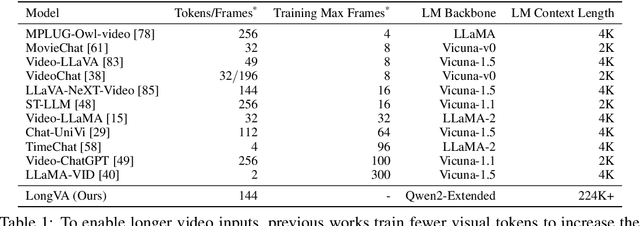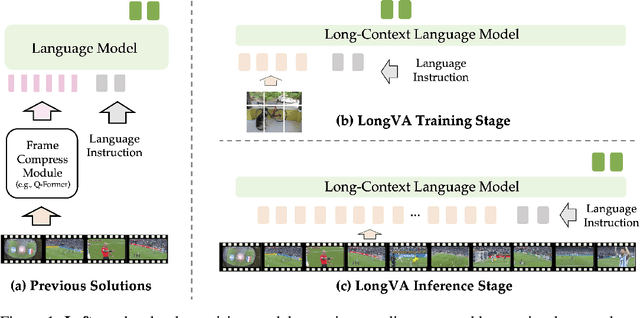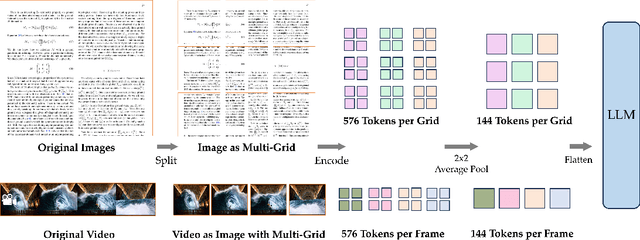Chunyuan Li
Painting with Words: Elevating Detailed Image Captioning with Benchmark and Alignment Learning
Mar 10, 2025Abstract:Image captioning has long been a pivotal task in visual understanding, with recent advancements in vision-language models (VLMs) significantly enhancing the ability to generate detailed image captions. However, the evaluation of detailed image captioning remains underexplored due to outdated evaluation metrics and coarse annotations. In this paper, we introduce DeCapBench along with a novel metric, DCScore, specifically designed for detailed captioning tasks. DCScore evaluates hallucinations and fine-grained comprehensiveness by deconstructing responses into the smallest self-sufficient units, termed primitive information units, and assessing them individually. Our evaluation shows that DCScore aligns more closely with human judgment than other rule-based or model-based metrics. Concurrently, DeCapBench exhibits a high correlation with VLM arena results on descriptive tasks, surpassing existing benchmarks for vision-language models. Additionally, we present an automatic fine-grained feedback collection method, FeedQuill, for preference optimization based on our advanced metric, showing robust generalization capabilities across auto-generated preference data. Extensive experiments on multiple VLMs demonstrate that our method not only significantly reduces hallucinations but also enhances performance across various benchmarks, achieving superior detail captioning performance while surpassing GPT-4o.
Video Instruction Tuning With Synthetic Data
Oct 03, 2024



Abstract:The development of video large multimodal models (LMMs) has been hindered by the difficulty of curating large amounts of high-quality raw data from the web. To address this, we propose an alternative approach by creating a high-quality synthetic dataset specifically for video instruction-following, namely LLaVA-Video-178K. This dataset includes key tasks such as detailed captioning, open-ended question-answering (QA), and multiple-choice QA. By training on this dataset, in combination with existing visual instruction tuning data, we introduce LLaVA-Video, a new video LMM. Our experiments demonstrate that LLaVA-Video achieves strong performance across various video benchmarks, highlighting the effectiveness of our dataset. We plan to release the dataset, its generation pipeline, and the model checkpoints.
LLaVA-Critic: Learning to Evaluate Multimodal Models
Oct 03, 2024Abstract:We introduce LLaVA-Critic, the first open-source large multimodal model (LMM) designed as a generalist evaluator to assess performance across a wide range of multimodal tasks. LLaVA-Critic is trained using a high-quality critic instruction-following dataset that incorporates diverse evaluation criteria and scenarios. Our experiments demonstrate the model's effectiveness in two key areas: (1) LMM-as-a-Judge, where LLaVA-Critic provides reliable evaluation scores, performing on par with or surpassing GPT models on multiple evaluation benchmarks; and (2) Preference Learning, where it generates reward signals for preference learning, enhancing model alignment capabilities. This work underscores the potential of open-source LMMs in self-critique and evaluation, setting the stage for future research into scalable, superhuman alignment feedback mechanisms for LMMs.
SAM2Point: Segment Any 3D as Videos in Zero-shot and Promptable Manners
Aug 29, 2024



Abstract:We introduce SAM2Point, a preliminary exploration adapting Segment Anything Model 2 (SAM 2) for zero-shot and promptable 3D segmentation. SAM2Point interprets any 3D data as a series of multi-directional videos, and leverages SAM 2 for 3D-space segmentation, without further training or 2D-3D projection. Our framework supports various prompt types, including 3D points, boxes, and masks, and can generalize across diverse scenarios, such as 3D objects, indoor scenes, outdoor environments, and raw sparse LiDAR. Demonstrations on multiple 3D datasets, e.g., Objaverse, S3DIS, ScanNet, Semantic3D, and KITTI, highlight the robust generalization capabilities of SAM2Point. To our best knowledge, we present the most faithful implementation of SAM in 3D, which may serve as a starting point for future research in promptable 3D segmentation. Online Demo: https://huggingface.co/spaces/ZiyuG/SAM2Point . Code: https://github.com/ZiyuGuo99/SAM2Point .
LLaVA-OneVision: Easy Visual Task Transfer
Aug 06, 2024



Abstract:We present LLaVA-OneVision, a family of open large multimodal models (LMMs) developed by consolidating our insights into data, models, and visual representations in the LLaVA-NeXT blog series. Our experimental results demonstrate that LLaVA-OneVision is the first single model that can simultaneously push the performance boundaries of open LMMs in three important computer vision scenarios: single-image, multi-image, and video scenarios. Importantly, the design of LLaVA-OneVision allows strong transfer learning across different modalities/scenarios, yielding new emerging capabilities. In particular, strong video understanding and cross-scenario capabilities are demonstrated through task transfer from images to videos.
LMMs-Eval: Reality Check on the Evaluation of Large Multimodal Models
Jul 17, 2024Abstract:The advances of large foundation models necessitate wide-coverage, low-cost, and zero-contamination benchmarks. Despite continuous exploration of language model evaluations, comprehensive studies on the evaluation of Large Multi-modal Models (LMMs) remain limited. In this work, we introduce LMMS-EVAL, a unified and standardized multimodal benchmark framework with over 50 tasks and more than 10 models to promote transparent and reproducible evaluations. Although LMMS-EVAL offers comprehensive coverage, we find it still falls short in achieving low cost and zero contamination. To approach this evaluation trilemma, we further introduce LMMS-EVAL LITE, a pruned evaluation toolkit that emphasizes both coverage and efficiency. Additionally, we present Multimodal LIVEBENCH that utilizes continuously updating news and online forums to assess models' generalization abilities in the wild, featuring a low-cost and zero-contamination evaluation approach. In summary, our work highlights the importance of considering the evaluation trilemma and provides practical solutions to navigate the trade-offs in evaluating large multi-modal models, paving the way for more effective and reliable benchmarking of LMMs. We opensource our codebase and maintain leaderboard of LIVEBENCH at https://github.com/EvolvingLMMs-Lab/lmms-eval and https://huggingface.co/spaces/lmms-lab/LiveBench.
LLaVA-NeXT-Interleave: Tackling Multi-image, Video, and 3D in Large Multimodal Models
Jul 10, 2024Abstract:Visual instruction tuning has made considerable strides in enhancing the capabilities of Large Multimodal Models (LMMs). However, existing open LMMs largely focus on single-image tasks, their applications to multi-image scenarios remains less explored. Additionally, prior LMM research separately tackles different scenarios, leaving it impossible to generalize cross scenarios with new emerging capabilities. To this end, we introduce LLaVA-NeXT-Interleave, which simultaneously tackles Multi-image, Multi-frame (video), Multi-view (3D), and Multi-patch (single-image) scenarios in LMMs. To enable these capabilities, we regard the interleaved data format as a general template and compile the M4-Instruct dataset with 1,177.6k samples, spanning 4 primary domains with 14 tasks and 41 datasets. We also curate the LLaVA-Interleave Bench to comprehensively evaluate the multi-image performance of LMMs. Through extensive experiments, LLaVA-NeXT-Interleave achieves leading results in multi-image, video, and 3D benchmarks, while maintaining the performance of single-image tasks. Besides, our model also exhibits several emerging capabilities, e.g., transferring tasks across different settings and modalities. Code is available at https://github.com/LLaVA-VL/LLaVA-NeXT
Long Context Transfer from Language to Vision
Jun 24, 2024



Abstract:Video sequences offer valuable temporal information, but existing large multimodal models (LMMs) fall short in understanding extremely long videos. Many works address this by reducing the number of visual tokens using visual resamplers. Alternatively, in this paper, we approach this problem from the perspective of the language model. By simply extrapolating the context length of the language backbone, we enable LMMs to comprehend orders of magnitude more visual tokens without any video training. We call this phenomenon long context transfer and carefully ablate its properties. To effectively measure LMMs' ability to generalize to long contexts in the vision modality, we develop V-NIAH (Visual Needle-In-A-Haystack), a purely synthetic long vision benchmark inspired by the language model's NIAH test. Our proposed Long Video Assistant (LongVA) can process 2000 frames or over 200K visual tokens without additional complexities. With its extended context length, LongVA achieves state-of-the-art performance on Video-MME among 7B-scale models by densely sampling more input frames. Our work is open-sourced at https://github.com/EvolvingLMMs-Lab/LongVA.
Beyond Raw Videos: Understanding Edited Videos with Large Multimodal Model
Jun 15, 2024



Abstract:The emerging video LMMs (Large Multimodal Models) have achieved significant improvements on generic video understanding in the form of VQA (Visual Question Answering), where the raw videos are captured by cameras. However, a large portion of videos in real-world applications are edited videos, \textit{e.g.}, users usually cut and add effects/modifications to the raw video before publishing it on social media platforms. The edited videos usually have high view counts but they are not covered in existing benchmarks of video LMMs, \textit{i.e.}, ActivityNet-QA, or VideoChatGPT benchmark. In this paper, we leverage the edited videos on a popular short video platform, \textit{i.e.}, TikTok, and build a video VQA benchmark (named EditVid-QA) covering four typical editing categories, i.e., effect, funny, meme, and game. Funny and meme videos benchmark nuanced understanding and high-level reasoning, while effect and game evaluate the understanding capability of artificial design. Most of the open-source video LMMs perform poorly on the EditVid-QA benchmark, indicating a huge domain gap between edited short videos on social media and regular raw videos. To improve the generalization ability of LMMs, we collect a training set for the proposed benchmark based on both Panda-70M/WebVid raw videos and small-scale TikTok/CapCut edited videos, which boosts the performance on the proposed EditVid-QA benchmark, indicating the effectiveness of high-quality training data. We also identified a serious issue in the existing evaluation protocol using the GPT-3.5 judge, namely a "sorry" attack, where a sorry-style naive answer can achieve an extremely high rating from the GPT judge, e.g., over 4.3 for correctness score on VideoChatGPT evaluation protocol. To avoid the "sorry" attacks, we evaluate results with GPT-4 judge and keyword filtering. The datasets will be released for academic purposes only.
MuirBench: A Comprehensive Benchmark for Robust Multi-image Understanding
Jun 13, 2024



Abstract:We introduce MuirBench, a comprehensive benchmark that focuses on robust multi-image understanding capabilities of multimodal LLMs. MuirBench consists of 12 diverse multi-image tasks (e.g., scene understanding, ordering) that involve 10 categories of multi-image relations (e.g., multiview, temporal relations). Comprising 11,264 images and 2,600 multiple-choice questions, MuirBench is created in a pairwise manner, where each standard instance is paired with an unanswerable variant that has minimal semantic differences, in order for a reliable assessment. Evaluated upon 20 recent multi-modal LLMs, our results reveal that even the best-performing models like GPT-4o and Gemini Pro find it challenging to solve MuirBench, achieving 68.0% and 49.3% in accuracy. Open-source multimodal LLMs trained on single images can hardly generalize to multi-image questions, hovering below 33.3% in accuracy. These results highlight the importance of MuirBench in encouraging the community to develop multimodal LLMs that can look beyond a single image, suggesting potential pathways for future improvements.
 Add to Chrome
Add to Chrome Add to Firefox
Add to Firefox Add to Edge
Add to Edge